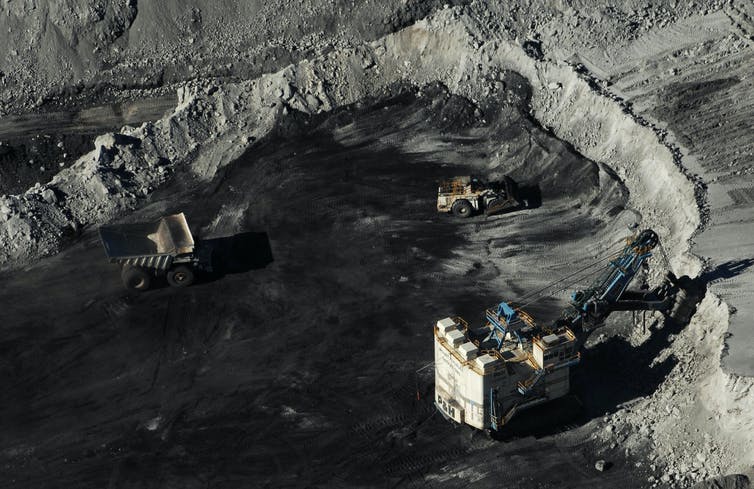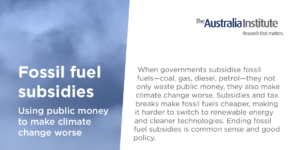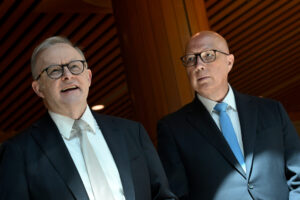Fossil fuel subsidies make government priorities clear

If Australia is to use and produce more fossil fuels than we are now, the rest of our climate policy amounts to tinkering at the edges, writes Rod Campbell.
Fossil fuel subsidies cost Australians $14.5 billion in 2023-24, equivalent to $27,581 for every minute of every day – $540 for every person in Australia.
That’s the estimate from the Australia Institute’s latest research on fossil fuel subsidies from Australian state, territory and federal governments.
It’s a large amount of money and, as budgets are delivered across the country, it’s one to remember when treasurers lament that they just can’t afford more public housing, cheaper education or resources for victims of partner violence.
Whenever a treasurer says they can’t afford something, they should be reminded that fossil fuel subsidies cost more than governments spend on the army, the air force, foreign aid or First Nations health.
But the $14.5 billion price tag isn’t even the worst part.
The really bad news is that fossil fuel subsidies are increasing – up 31% from 2022-23 – and they are increasing because Australian governments expect to use and produce more fossil fuels in the future, not less.
If Australia is to use and produce more fossil fuels than we are now, the rest of Australian climate policy is just tinkering at the edges.
All the high-vis visits to battery factories, all of the koala hugging and Barrier Reef hand-wringing – it’s all a fraud if the country is going to increase fossil fuel use.
The biggest fossil fuel subsidy is the Fuel Tax Credit Scheme, which pays back any fuel tax paid by eligible fuel users, the biggest of which is the mining industry. The scheme cost the Federal Budget almost $10 billion in 2023-24. Almost $1 billion of that went to the coal industry.
The cost of this tax break is expected to increase to $11 billion in 2026-27 because, in Treasury’s words, “of an expected increase in the use of fuels that are eligible”, particularly diesel.
Australia is planning to use more diesel, not less. It’s not just the big trucks of the mining industry.
Similar tax breaks on aviation fuel are set to increase from $1.6 billion in 2023–24 to $2 billion in 2026-27, because Australian Governments are planning for Australians to use more fossil fuels flying, not less.
Australian governments are subsidising fossil fuel production and exports, too. The Queensland Government has a $520 million Low Emissions Investment Partnership, which “to be eligible for the program, a proponent must…own or operate a Queensland coal mining facility”. It aims to achieve “a sustainable future for the [coal] industry”.
Queensland also has a $21 million grants program to “unlock significant gas resources in the Bowen and Galilee basins”.
More coal and gas mining, not less.
The NT Government has committed $3 billion to gas purchases and pipeline agreements, not including its recently announced deal to buy fracked gas from the Beetaloo Basin.
The NT Government has committed so much to fossil gas that renewable energy is a threat to its gas business. In their words, “the potential impact from the displacement of gas by renewables over time is a risk to the [NT Government-owned] corporation’s ability to sell the gas at a price higher than the cost of gas and transport.”
The NT Government wants to produce and use more fossil fuels and sees renewable energy as a “risk”.
The New South Wales Government just announced a new subsidy for the Eraring coal-fired power station, which will appear in next year’s report alongside spending from the $45 million NSW Coal Innovation Fund. More coal, not less.
Even the South Australian Government, which has led the country in renewable energy development, says in its budget that it expects higher oil and gas royalties in the future “with growth in future years supported by increased petroleum production”.
More oil and gas, not less.
This is the reality of what state and federal governments are planning for Australia’s environment and economy.
Until governments start planning for a reduction in fossil fuel production and use, everything else is greenwash. The Net Zero Authority, Safeguard Mechanism, Vehicle Efficiency Standards – none of these are worth anything while governments are planning to increase subsidies for an expanded coal industry.
Carbon offsets, emissions accounting protocols, carbon capture and storage proposals – these are all greenwash for the ugly brown truth that Australia’s governments are acting against the interests of the community, the economy and the planet.
Budgets are about choices, and the recent choices made by Australian governments are very clear.
Between the Lines Newsletter
The biggest stories and the best analysis from the team at the Australia Institute, delivered to your inbox every fortnight.
You might also like
Fossil fuel subsidies
When governments subsidise fossil fuels—coal, gas, diesel, petrol—they not only waste public money, they also make climate change worse. Subsidies and tax breaks make fossil fuels cheaper, making it harder to switch to renewable energy and cleaner technologies. Ending fossil fuel subsidies is common sense and good policy.
Why a fossil fuel-free COP could put Australia’s bid over the edge
When the medical world hosts a conference on quitting smoking, they don’t invite Phillip Morris, or British American Tobacco along to help “be part of the solution”.
5 ways and 63 billion reasons to improve Australia’s tax system
With a federal election just around the corner, new analysis from The Australia Institute reveals 63 billion reasons why our next Parliament should improve the nation’s tax system.


